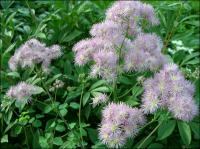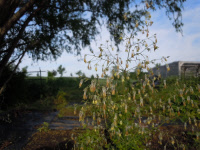Plants for Butterflies and Other Pollinators
Showing 185–192 of 211 results
-
Succisa pratensis Devil’s bit scabiosus Z 5- 9
A tall, thin stem, unbranched until its upper quarter, then branching, each branch topped with its own flower head. Innumerable tiny flowers surround a global, lake-blue flower head, about the size of a ping-pong ball. Thread-like stamens poke out from the flowers all around the globe – blue too. Blooms for nearly three months mid-to-late summer into fall.
A tall, thin stem, unbranched until its upper quarter, then branching, each branch topped with its own flower head. Innumerable tiny flowers surround a global, lake-blue flower head, about the size of a ping-pong ball. Thread-like stamens poke out from the flowers all around the globe – blue too. Blooms for nearly three months mid-to-late summer into fall.
LIMITED QUANTITIES AVAILABLE, LIMIT OF 1 PER CUSTOMER PLEASE
Size: 2-4’ x 12”
Care: sun to part shade in moist to moist-well drained soil
Native: Europe to central Siberia, NW Africa
Wildlife Value: provides nectar and pollen to butterflies, moths, and beesHistorically this has made a dye, a tea, and seasoned food. It treated numerous medical conditions including scabies, eczema, fevers, wounds, syphilis and plague. Devil’s bit named for the legend that the Devil disapproved of the plant uses and attempted to destroy it by biting off its roots. First described by Swiss botanist Gaspard Bauhin in 1623, Pinax theatri botanici, with a different name. Linnaeus renamed it in Hortus Cliffortanus, 1737and then Möench renamed it to Succisa pratensis in 1794.
-
Symphoricarpos albus Snowberry Z 3-7
Small pink bell-shaped flowers turn into copious clusters of round, white berries, like miniature snowballs, grace this shrub from late summer through winter.
OUT OF STOCK
Small pink bell-shaped flowers turn into copious clusters of round, white berries, like miniature snowballs, grace this shrub from late summer through winter.
Size: 3-6’ x 3-6’
Care: sun to part shade in moist well-drained to well-drained soil
Native: Canada east to west coasts; US all states north from Virginia to California. Wisconsin native.
Wildlife Value: deer tolerant, attracts numerous birds including Hummingbirds, Towhees, Grouses, Robins, and Waxwings for nesting and food, although the fruit is poison to humans. Bees flock to the flowers’ pollen. Host for caterpillars of the Snowberry Sphinx moth and Snowberry Clearwing moth.Pauites of Oregon constructed cradle boards with the wood, sharpened the stem for digging tool and used its branches in a game of dice. The Nez Perce boiled sticks in water then used to remedy fevers, and encircled its branches around cradleboards to protect babies from ghosts. Flathead cured injured eyes with juice for the fruit and made a paste of its fruit, bark and leaves to remedy skin ailments and burns. For the Blackfoot the smoke from burning twigs blackened newly made pipes. Sioux made a diauretic from the fruit. Ojibwa speeded up convalescence for new mothers after giving birth with water infused with this. Shoshone made arrows from shoots for small birds. Collected for botany before 1753. Also collected on Lewis and Clark Expedition along the Missouri River west of Council Bluffs.
**LISTED AS OUT OF STOCK BECAUSE WE DO NOT SHIP THIS ITEM. IT IS AVAILABLE FOR PURCHASE AT OUR RETAIL LOCATION.
-
Symphyandra zanzegura syn Campanula zanzegura Ring bellflower, Rock bellflower Z 5-10
Flared petal ends of lilac bells on wiry red stems over soft, velvety leaves bloom much of summer.
OUT OF STOCK
Flared petal ends of lilac bells on wiry red stems over soft, velvety leaves bloom much of summer.
Size: 15” x 15”
Care: full to part shade in well-drained soil
Native: mountains of Armenia, Eastern Europe
Wildlife Value: attracts beesDescribed and published by Ukrainian botanist Vladimir Lipsky (1863-1937) in 1894. Reclassified as a Campanula in 1980.
-
Syneilesis aconitifolia syn Senecio aconitifolius Shredded Umbrella Plant Z 3-8
Grown for its excellent foliage in dry shade. I guess “Shredded umbrella” best describes this plant with thin, dissected leaves atop a leafless stem. drooping in a rounded shape, like an umbrella, but it wouldn’t shelter from rain. Pale pink to white flowers in early to mid-summer.
OUT OF STOCK
Grown for its excellent foliage in dry shade. “Shredded umbrella” best describes this plant with thin, dissected leaves atop a leafless stem. Drooping in a rounded shape, like an umbrella, but it wouldn’t shelter from rain. Pale pink to white flowers in early to mid-summer.
Size: 3’ x 2’, spreads slowly by rhizomes
Care: part to full shade in moist, well-drained to well-drained soil. Drought tolerant once established.
Native: China, Korea & Japan and eastern Russia
Wildlife Value: Attracts bees, butterflies and birds. Deer and rabbit resistant.Described in Flora of China in 1833. Chinese used the whole plant for medicine, to relax and activate the tendons, alleviate pain around the waist and legs, and to treat most any injuries.
-
Teucrium hircanicum syn. T hyrcanicum Iranian germander, Purple Tails, Wood Sage Z 5-8
Loads of deep purple erect spikes from mid-summer through fall making this subshrub one of the best
Loads of deep purple erect spikes from mid-summer through fall making this subshrub one of the best
Size: 18-24” x 24”
Care: sun in moist well-drained to well-drained soil
Native: Caucausus and Iran
Wildlife Value: attract butterflies, deer resistantDescribed and named by 1753
-
Thalictrum aquilegifolium Meadowrue, Feathered columbine Z 5-9
Delicate lavender to pink panicles of showy stamens in early summer
Delicate lavender to pink panicles of showy stamens in early summer
Size: 36" x 18"
Care: Sun to part shade in moist humusy soil
Native: Europe and North Asia
Wildlife Value: attracts Black swallowtail butterflyThalictrum is from Greek meaning “to flourish” or “look green.” In 1629 Parkinson, apothecary to James I and later, botanist to Charles I, called this “Tufted columbine” a descriptive name, the flowers are tufted, and the leaves resemble those of a columbine. Ancient Romans used it to cure ulcers, the plague and “the Faundife.” Romans stuffed children’s’ pillows with the flowers to bring them wealth. Liberty Hyde Bailey described Thalictrum aquilegifolium as: “A good garden plant and frequently planted,”(1933). Cultivated in U.S. since 1700’s.
-
Thalictrum coriaceum Maid of the Mist Z 5-7
Broad panicle of white flowers with maroon-colored filaments and tips of stigma flowering May to June
Broad panicle of white flowers with maroon-colored filaments and tips of stigma flowering May to June
Size: 3-5’ x 2’
Care: sun to shade in moist to moist well-drained soil
Native: Uncommon, central and southern Appalachian endemic, Pennsylvania to northern Georgia west to West Virginia and Tennessee, primarily in the mountainsFirst described in 1891 in “Torrey Bot. Club” 18:363, 1891. Collected on Rock Table and Stone Mountains in North Carolina in 1891 by J.K. Small (1869-1938) and A.A. Heller and by “Professor Porter in the same region many years before.”
-
Thalictrum minus ‘Adiantifolium’ Fernleaf meadowrue Z 4-8
Loose panicles of tiny yellowish flowers top fern-like foliage in mid-summer.
Loose panicles of tiny yellowish flowers top fern-like foliage in mid-summer.
Size: 36" x 24"
Care: part shade in moist to moist well-drained soil.
Native: Europe, North Africa & Siberia
Wildlife Value: Attracts Black swallowtail butterfly, Deer resistant.
Awards: Rated as excellent by the Chicago Botanic Garden.Thalictrum is from Greek meaning “to flourish” or “look green.” The species grown by English herbalist Gerard (1545-1612) in the 1590’s.



